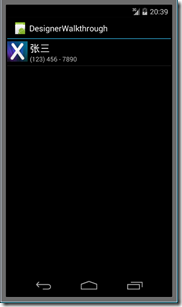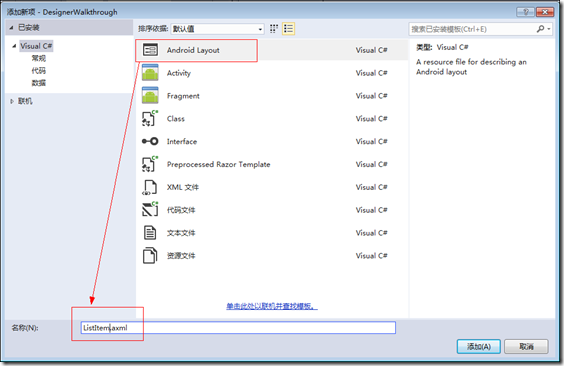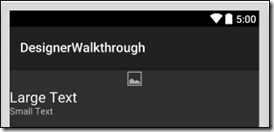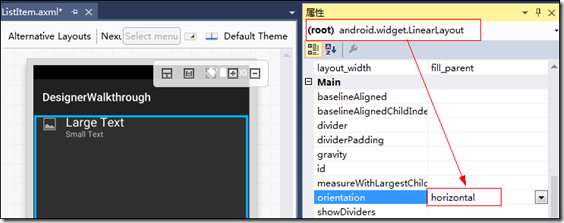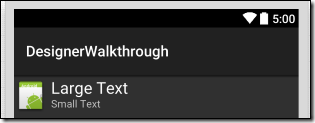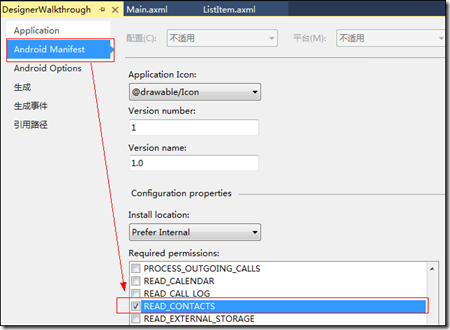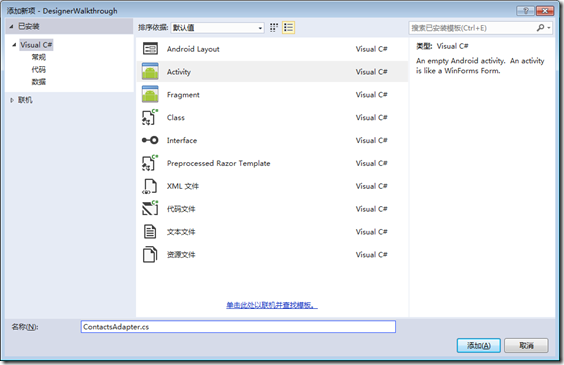分类:C#、Android、VS2015;创建日期:2016-02-06
项目名:DesignerWalkthrough
模板:Blank App(Android)
功能:列出手机上的所有联系人。
说明:该例子提前使用了第9章介绍的列表视图。
运行效果:
下图是在模拟器(Galaxy_Api19)下看到的运行效果:
注意:需要先在模拟器的通讯录中添加联系人,然后才能看到运行效果。
主要设计步骤:
(1)在ListItem.axml中设计列表项模板
新建VS2015项目,模板:“Blank App (Android)”,项目名:DesignerWalkthrough
鼠标右击Resources/layout文件夹,【添加】à【新建项】,在弹出的窗口中,选择【Android Layout】模板,文件名:ListItem.axml,单击【添加】按钮。
拖放Placeholder.png到drawable文件夹下。
从【工具箱】中拖放【ImageView】控件到设计界面中。
从【工具箱】中拖放【LinearLayout (Vertical)】控件到设计界面中,放到【ImageView】的下方。
从【工具箱】中拖放【Text (Large)】控件到设计界面中,放到【LinearLayout (Vertical)】内。
从【工具箱】中拖放【Text (Small)】控件到【Text (Large)】的下方。
下面修改布局,目标是:将ImageView放到两个Text的左边:
缩小ImageView的宽度,然后修改根目录下的LinearLayout控件,在【属性】窗口中,将其【orientation】属性改为“horizontal”,即得到下面的效果:
技巧:利用【文档大纲(Document Outline)】选择要操作的控件,然后再利用【属性】窗口设置对应的属性。
设置ImageView的属性:
src:选择icon.png图片,得到该属性的值为“@drawable/icon”。
paddingLeft:0dp
paddingTop:5dp
paddingRight:5dp
paddingBottom:0dp
layoutWidth:50dp
layoutHeight:50dp
adjustViewBounds:true
minWidth:25dp
minHeight:25dp
设置LinearLayout1的属性:
paddingLeft:0dp
paddingTop:5dp
paddingRight:5dp
paddingBottom:0dp
最终得到的结果如下:
最终得到的【Source】选项卡中对应的XML如下:
<?xml version="1.0" encoding="utf-8"?> <LinearLayout xmlns:android="http://schemas.android.com/apk/res/android" android:orientation="horizontal" android:layout_width="fill_parent" android:layout_height="fill_parent"> <ImageView android:src="@drawable/icon" android:layout_width="50dp" android:layout_height="50dp" android:id="@+id/imageView1" android:adjustViewBounds="true" android:paddingLeft="0dp" android:paddingRight="5dp" android:paddingBottom="0dp" android:paddingTop="5dp" android:minHeight="25dp" android:minWidth="25dp" /> <LinearLayout android:orientation="vertical" android:layout_width="match_parent" android:layout_height="wrap_content" android:id="@+id/linearLayout1" android:paddingTop="5dp" android:paddingBottom="5dp" android:paddingLeft="0dp" android:paddingRight="0dp"> <TextView android:text="Large Text" android:textAppearance="?android:attr/textAppearanceLarge" android:layout_width="match_parent" android:layout_height="wrap_content" android:id="@+id/textView1" /> <TextView android:text="Small Text" android:textAppearance="?android:attr/textAppearanceSmall" android:layout_width="match_parent" android:layout_height="wrap_content" android:id="@+id/textView2" /> </LinearLayout> </LinearLayout>
(2)在Main.axml中添加列表
打开Main.axml。
删除默认添加的按钮。
从【工具箱】中拖放一个ListView到设计界面中,然后修改属性:
id:@+id/listViewContacts
最后得到的XML如下:
<?xml version="1.0" encoding="utf-8"?> <LinearLayout xmlns:android="http://schemas.android.com/apk/res/android" android:orientation="vertical" android:layout_width="fill_parent" android:layout_height="fill_parent" android:minWidth="25px" android:minHeight="25px"> <ListView android:minWidth="25px" android:minHeight="25px" android:layout_width="match_parent" android:layout_height="match_parent" android:id="@+id/listViewContacts" /> </LinearLayout>
(3)修改权限配置
修改项目属性,添加【READ_CONTACTS】权限:
修改后,得到的AndroidMinifest.xml内容如下:
<?xml version="1.0" encoding="utf-8"?> <manifest xmlns:android="http://schemas.android.com/apk/res/android" package="DesignerWalkthrough.DesignerWalkthrough" android:versionCode="1" android:versionName="1.0" android:installLocation="auto"> <uses-sdk /> <application android:label="DesignerWalkthrough" android:icon="@drawable/Icon"></application> <uses-permission android:name="android.permission.READ_CONTACTS" /> </manifest>
(4)添加ContactsAdapter.cs
选择【Class】模板,输入文件名,然后将ContactsAdapter.cs的代码改为下面的内容:
using Android.Views; using Android.Widget; using Android.Content; using Android.App; using Android.Provider; using System.Collections.Generic; namespace DesignerWalkthrough { public class ContactsAdapter : BaseAdapter { List<Contact> _contactList; Activity _activity; public ContactsAdapter(Activity activity) { _activity = activity; FillContacts(); } public override int Count { get { return _contactList.Count; } } public override Java.Lang.Object GetItem(int position) { return null; } public override long GetItemId(int position) { return _contactList[position].Id; } public override View GetView(int position, View convertView, ViewGroup parent) { var view = convertView ?? _activity.LayoutInflater.Inflate(Resource.Layout.ListItem, parent, false); var contactName = view.FindViewById<TextView>(Resource.Id.textView1); var textView2 = view.FindViewById<TextView>(Resource.Id.textView2); var contactImage = view.FindViewById<ImageView>(Resource.Id.imageView1); textView2.Text = _contactList[position].Number; contactName.Text = _contactList[position].DisplayName; if (_contactList[position].PhotoId == null) { contactImage = view.FindViewById<ImageView>(Resource.Id.imageView1); contactImage.SetImageResource(Resource.Drawable.Placeholder); } else { var contactUri = ContentUris.WithAppendedId(ContactsContract.Contacts.ContentUri, _contactList[position].Id); var contactPhotoUri = Android.Net.Uri.WithAppendedPath(contactUri, ContactsContract.Contacts.Photo.ContentDirectory); contactImage.SetImageURI(contactPhotoUri); } return view; } void FillContacts() { var uri = ContactsContract.Contacts.ContentUri; string[] projection = { ContactsContract.Contacts.InterfaceConsts.Id, ContactsContract.Contacts.InterfaceConsts.DisplayName, ContactsContract.Contacts.InterfaceConsts.PhotoId }; var cursor = _activity.ContentResolver.Query(uri, projection, null, null, null); _contactList = new List<Contact>(); if (cursor.MoveToFirst()) { do { _contactList.Add(new Contact { Id = cursor.GetLong(cursor.GetColumnIndex(projection[0])), DisplayName = cursor.GetString(cursor.GetColumnIndex(projection[1])), PhotoId = cursor.GetString(cursor.GetColumnIndex(projection[2])), Number = "(123) 456 - 7890" }); } while (cursor.MoveToNext()); } } class Contact { public long Id { get; set; } public string DisplayName { get; set; } public string PhotoId { get; set; } public string Number { get; set; } } } }
(5)修改MainActivity.cs
将MainActivity.cs的代码改为下面的内容:
using Android.App; using Android.Widget; using Android.OS; namespace DesignerWalkthrough { [Activity(Label = "DesignerWalkthrough", Theme = "@android:style/Theme.DeviceDefault.Light", MainLauncher = true, Icon = "@drawable/icon")] public class MainActivity : Activity { protected override void OnCreate(Bundle bundle) { base.OnCreate(bundle); SetContentView(Resource.Layout.Main); var contactsAdapter = new ContactsAdapter(this); var contactsListView = FindViewById<ListView>(Resource.Id.listViewContacts); contactsListView.Adapter = contactsAdapter; } } }
(6)运行
选择一种模拟器,然后按<F5>键调试运行。
